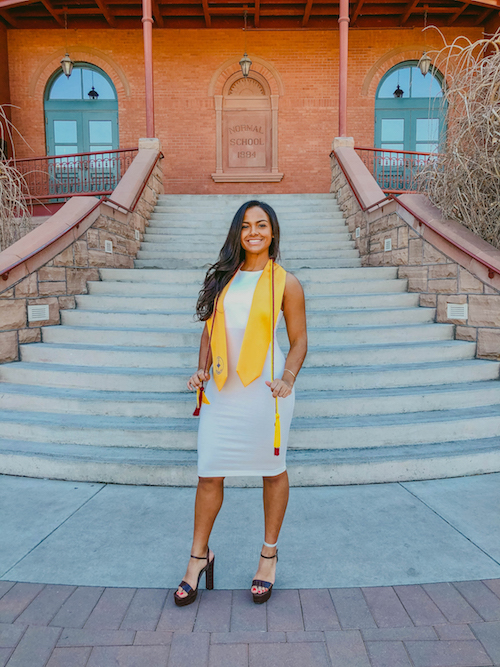ASU aerospace grad shoots for the stars
Adrianna Conway, spring 2020 aerospace engineering graduate, is aiming to shoot for the stars, literally.
At the age of 16 Conway decided her top career goal would be to go to space.
“It is definitely still my goal,” Conway said.
As a high schooler, Conway decided that ASU would be the best place to pursue her goal of becoming an astronaut.
“ASU had offered me the best scholarship, and the engineering program looked good. So I took it as a sign to keep moving forward,” she said.

ASU graduate Adrianna Conway
Conway, who was born in Seattle but grew up in Chandler, explained that she chose to study aerospace engineering not only because it would help her reach the stars but also because she has a passion for work in the rocketry field.
“I thought if I’m literally shooting for the stars and I don’t [get there], then I would love to work in the rocketry field. Either way, if I make it as far as I want to make it that would be awesome, or I’m in a career field that I have a passion about and that I care about,” Conway said.
Looking to the future Conway is deciding if she will pursue a master’s degree in aerospace engineering.
While at ASU Conway was a member of the National Society of Black Engineers and the rocketry club. Conway also worked as a group fitness instructor at the Sun Devil Fitness Complex for four years, a community assistant in the engineering residence hall, Tooker House for two years and an undergraduate teaching assistant.
Conway was also the recipient of the Provost Scholarship.
As she graduated, she shared her reflections on her time at ASU and her advice for Sun Devils.
Question: What was your “aha” moment, when you realized you wanted to study the field you majored in?
Answer: When I was halfway through high school, I kind of thought to myself, OK, eventually I’m going to graduate and go to college. I hadn’t pinpointed what I wanted to do. So at 16 I kind of stopped and asked myself, if you could do anything with no chance of failure what would you want to do?
And I decided I would love to go to space. That would be my top-tier goal if I could do absolutely anything I would love to go to space one day. So then I decided to start crafting a resume that would make me a good candidate for that.
Q: What’s something you learned while at ASU — in the classroom or otherwise — that surprised you or changed your perspective?
A: One resource that ASU offers that I found to be the most useful was the engineering tutoring center. I didn’t think that making the leap to engineering would be difficult, but it turned out to be very difficult for me.
I started going and I met more friends there, and it really helped me get a better grasp on content. I went there for probably three years and even when I wasn’t there getting help I was there learning or doing homework, and that was a really awesome resource and a really awesome space to go and get help.
I know people tell you to go to tutoring but I’m serious when I say it’s helpful and it’s free.
Q: What are your plans after graduation?
A: I have been working as an intern with a company called Northrop Grumman. They offered me a full-time position at the end of 2019 in December. They offered me to be a full-time employee in the department that I’ve been working in, called Mission Insurance.
Q: If someone gave you $40 million to solve one problem on our planet, what would you tackle?
A: That’s a really hard question for me because when I tell people I want to go to space or I care about space explorations, people’s responses are like, well what about earth. There are all these problems that we need to tackle on earth, and it’s not that I don’t care about earth and would want to leave it behind, it’s more about just that we are so microscopic in the scheme of things that there’s so much out there to be explored and that’s just what I’m excited about and want to pursue.
But I don’t want earth to be left behind … so I guess I would work on climate change and definitely try to extend the lifespan of earth.